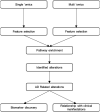The promise of multi-omics approaches to discover biological alterations with clinical relevance in Alzheimer's disease
- PMID: 36570537
- PMCID: PMC9768448
- DOI: 10.3389/fnagi.2022.1065904
The promise of multi-omics approaches to discover biological alterations with clinical relevance in Alzheimer's disease
Abstract
Beyond the core features of Alzheimer's disease (AD) pathology, i.e. amyloid pathology, tau-related neurodegeneration and microglia response, multiple other molecular alterations and pathway dysregulations have been observed in AD. Their inter-individual variations, complex interactions and relevance for clinical manifestation and disease progression remain poorly understood, however. Heterogeneity at both pathophysiological and clinical levels complicates diagnosis, prognosis, treatment and drug design and testing. High-throughput "omics" comprise unbiased and untargeted data-driven methods which allow the exploration of a wide spectrum of disease-related changes at different endophenotype levels without focussing a priori on specific molecular pathways or molecules. Crucially, new methodological and statistical advances now allow for the integrative analysis of data resulting from multiple and different omics methods. These multi-omics approaches offer the unique advantage of providing a more comprehensive characterisation of the AD endophenotype and to capture molecular signatures and interactions spanning various biological levels. These new insights can then help decipher disease mechanisms more deeply. In this review, we describe the different multi-omics tools and approaches currently available and how they have been applied in AD research so far. We discuss how multi-omics can be used to explore molecular alterations related to core features of the AD pathologies and how they interact with comorbid pathological alterations. We further discuss whether the identified pathophysiological changes are relevant for the clinical manifestation of AD, in terms of both cognitive impairment and neuropsychiatric symptoms, and for clinical disease progression over time. Finally, we address the opportunities for multi-omics approaches to help discover novel biomarkers for diagnosis and monitoring of relevant pathophysiological processes, along with personalised intervention strategies in AD.
Keywords: Alzheimer’s disease; biomarkers; clinical relevance; integration; multi-omics; personalised medicine.
Copyright © 2022 Clark, Rabl, Dayon and Popp.
Conflict of interest statement
The authors declare that the research was conducted in the absence of any commercial or financial relationships that could be construed as a potential conflict of interest.
Figures
References
Publication types
LinkOut - more resources
Full Text Sources


